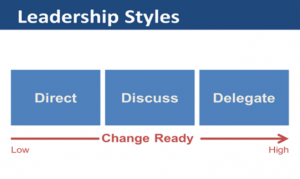Leadership Styles--The Three Ds

Leadership
June 26, 2020
Paul B. Thornton
Author, Speaker, and Adjunct Professor
Topics
Authentic leadership, delegate, direct, discuss, Leadership, leadership style, leadership stylesLeaders influence and inspire people to make positive changes to improve the status quo!
How many different leadership styles are there?
- The Leadership Grid—created by Robert Blake and Jane Mouton describes five leadership styles.
- The Situational Leadership Theory Model—developed by Paul Hersey and Ken Blanchard describes four leadership styles.
I think we can boil it down to three predominant styles—directing, discussing, and delegating.

Using the right leadership style, helps people make the required changes and become more effective.
Are you proficient at using all three styles?
Directing Leadership Style
The leader tells a person or group what changes are needed and why they are necessary. Specifically, the leader describes—the goal, plan, and deadline.
- Goal—Your goal is to make all the customer service reps fully proficient in using all aspects of the new software.
- Plan—I want you to do these five things.
- Deadline—You must have this completed and implemented by the end of the fourth quarter.
Communication is predominantly one-way, from leader to employee. The only feedback the leader looks for is, “Do you understand the instructions?”
The directing style is appropriate when people lack the required ability and motivation to make the required change. In this situation, people want and need precise directions on what to do and how to do it.
Discussing Leadership Style
Over 2,000 years ago, Socrates realized that leading was more a matter of asking the right questions than giving answers. The best leaders ask questions that engage and motivate people to identify what’s needed to solve problems and pursue opportunities. Their questions relate to the goal, plan, and deadline.
- Goal—What’s our objective? What can we do that’s never been done before? What should our goal be? What are we trying to accomplish?
- Plan—What actions are required? What obstacles do you anticipate? How will we overcome them? Who is the best person to do each task? What did you learn from the last implementation?
- Deadline—What’s a realistic timeframe to complete this change initiative? How will people react to that deadline? What other priorities may impact this deadline?
Communication is two-way—between leader and followers. It requires openness and collaboration. Leaders ask probing questions; facilitate the discussion, and spend significant time listening.
The discussing style is appropriate when a person has some experience, skills, and willingness to change. They have ideas to contribute and insights to share in the planning and decision-making process.
The Delegating Leadership Style
Effective leaders empower experienced people to establish their own goals, plans, and deadlines. They challenge and stretch people to determine what changes are needed and how best to implement those changes.
On big change initiatives, effective leaders require periodic updates to ensure appropriate progress is being made.
The delegating style is appropriate when people are highly capable and energized to do what’s needed to improve the status quo.
What is the Appropriate Style?
There is no one best style.
Each style is appropriate and effective in certain situations.
The best leaders diagnose the situation by considering relevant factors such as customers’ wants and needs, the competition, time constraints as well as people’s knowledge, skills, motivation, and openness to change.
When people lack the required skills and experience, start by directing them. As people gain experience and know-how, it’s best to engage them through discussion and then delegation.
Using the appropriate leadership style helps people learn, grow, and become more independent.
Summary
Things to remember…
Use a leadership style that fits the needs of the situation. Every situation is unique.
Most leaders have a “go-to” style that they use the majority of the time. It’s important to broaden your skill-set and be proficient at using all three leadership styles.
What style will you work on? Identify one thing you will do today.






